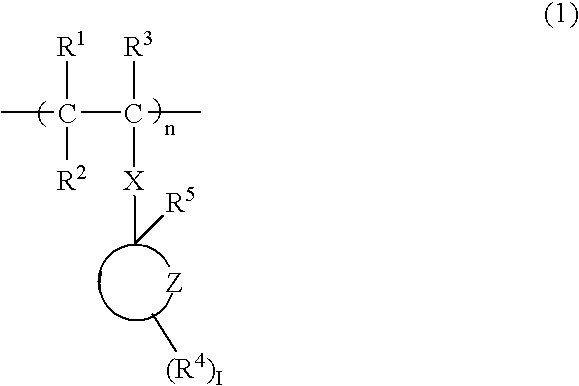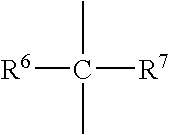Polymer compound, resist composition and dissolution inhibitor agent containing the polymer compound
a technology of dissolution inhibitor agent and polymer compound, which is applied in the direction of photosensitive materials, instruments, photomechanical apparatuses, etc., can solve the problems of not yet being elucidated and unable to obtain the next generation of resist composition based on the conventional resist materials
- Summary
- Abstract
- Description
- Claims
- Application Information
AI Technical Summary
Benefits of technology
Problems solved by technology
Method used
Image
Examples
synthesis example 3
Resin Synthesis Example 3
[0060] First, 4.40 grams of 2-methyl-2-adamantyl acrylate, 3.12 grams of γ-butyrolactone acrylate, and 4.74 grams of 3-hydroxyperfluoroadamantyl acrylate were dissolved in 50 milliliters of tetrahydrofuran, and further 0.61 grams of azobisisobutyronitrile was added. After heating at 70° C. for 5 hours under reflux, the resultant solution was added dropwise to 1 liter of n-heptane. The precipitated resin was filtered off, and dried under reduced pressure to obtain a resin. The resin was a polymer compound having three types of monomeric units represented respectively by general formulas (4), (5) below and the general formula (3) mentioned above. The yield of the resin was 7.0 grams. The weight-average molecular weight (Mw) of the resin was 5,100 and the degree of dispersion (Mw / Mn) was 2.37. Hereinafter, the resin will be referred to as Resin 3. Note that, in general formulas (4) and (5) below, p and q are integers. The obtained polymer compound is useful as ...
synthesis example 4
Resin Synthesis Example 4
[0061] First, 2.8 grams of a lactone monomer and 2.4 grams of 3-hydroxy perfluoroadamantyl acrylate were dissolved in 90 milliliters of tetrahydrofuran, and further 0.15 grams of azobisisobutyronitrile was added. After heating at 70° C. for 5 hours under reflux, the resultant solution was added dropwise to 1 liter of n-heptane. The resultant solid matter was filtrated, and dried at 40° C. for 3 hours under vacuum. 3.0 g of the obtained resin was dissolved in 100 milliliters of tetrahydrofuran and 110 grams of tetramethyl ammonium hydroxide (TMAH) was added. After the solution mixture was stirred at room temperature for 6 hours, the mixture was neutralized with 0.04N of HCl. The hydrolyzed resin was extracted with ethyl acetate. The organic layer was washed with pure water and added dropwise to 1 liter of n-heptane. The precipitated resin was filtrated off and dried at 30° C. for 2 hours under vacuum to obtain a resin. The resin was a polymer compound having ...
synthesis example 1
Comparative Resin Synthesis Example 1
[0062] First, 10.0 grams of 1-adamantyl methacrylate was dissolved in 50 milliliters of tetrahydrofuran and 0.5 grams of azobisisobutyronitrile was added. After heating at 70° C. for 5 hours under reflux, the resultant solution was added dropwise to 1 liter of methanol. The precipitated resin was filtered off, and dried under reduced pressure to obtain a resin. The resin was a polymer compound having a monomeric unit represented by general formula (7) below. The yield of the resin was 8.0 grams. The weight-average molecular weight (Mw) of the resin was 6,000 and the degree of dispersion (Mw / Mn) was 1.5. Hereinafter, the resin will be referred to as Comparative Resin 1.
PUM
| Property | Measurement | Unit |
|---|---|---|
| Nanoscale particle size | aaaaa | aaaaa |
| Wavelength | aaaaa | aaaaa |
| Wavelength | aaaaa | aaaaa |
Abstract
Description
Claims
Application Information
 Login to View More
Login to View More - R&D
- Intellectual Property
- Life Sciences
- Materials
- Tech Scout
- Unparalleled Data Quality
- Higher Quality Content
- 60% Fewer Hallucinations
Browse by: Latest US Patents, China's latest patents, Technical Efficacy Thesaurus, Application Domain, Technology Topic, Popular Technical Reports.
© 2025 PatSnap. All rights reserved.Legal|Privacy policy|Modern Slavery Act Transparency Statement|Sitemap|About US| Contact US: help@patsnap.com



